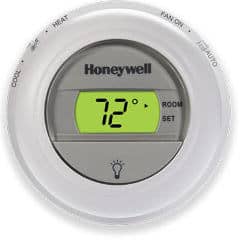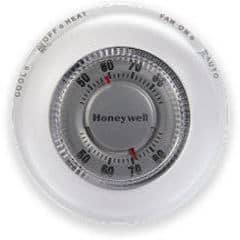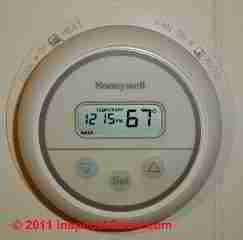 HVAC Thermostat Settings
HVAC Thermostat Settings
How to set or adjust the heating or cooling thermostat in buildings
- POST a QUESTION or COMMENT about line voltage thermostats
Heating or cooling room settings: how to adjust the room thermostat for heating or air conditioning: how to set the thermostat to the desired temperature & how to diagnose thermostat setting problems. We describe how to find the current room temperature and how to compare it to the set temperature or target temperature on the thermostat.
InspectAPedia tolerates no conflicts of interest. We have no relationship with advertisers, products, or services discussed at this website.
- Daniel Friedman, Publisher/Editor/Author - See WHO ARE WE?
Heating & Cooling Control Thermostat Setting Guide
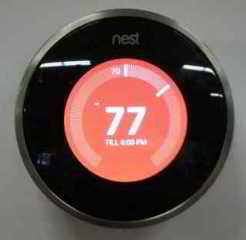 Using Wall-Mounted Room Thermostats - How to Set the Thermostat
Using Wall-Mounted Room Thermostats - How to Set the Thermostat
Detailed photos of the major components of a wall thermostat and a description of how heating & cooling thermostats work are provided below. If your heating system is not working at all, start at HEAT WON'T TURN ON.
Remote Control Thermostats & Remote Heat, Cooling, or Building Temperature Monitoring
A variety of remote control thermostats are offered by HVAC control manufacturers, permitting an owner to monitor, or even change building temperature control settings remotely by telephone or by web-enabled internet connection.
Also see FREEZE-PROOF A BUILDING
Proliphix provides a range of energy control thermostats that offer remote temperature control via web-enabled communication between an individual and the building's HVAC controls.
Also see Honeywell Controls, and White Rodgers thermostat controls documents atReferences or Citations
See NEST ROOM THERMOSTATS (shown at above left) for details about this top-end programmable room thermostat that can be controlled remotely by cellphone.
How to Set a Room Thermostat To the Desired Temperature
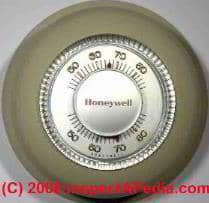 Here is our photo of a traditional round Honeywell (R) round room thermostat.
Here is our photo of a traditional round Honeywell (R) round room thermostat.
Heating thermostats:
Here we use a traditional, and very simple dial-type round wall-mounted thermostat as an example. Notice that the thermostat face has two temperature scales and two pointers.
The top scale on the thermostat and the red arrow shows the "set" temperature that the thermostat is asking for.
The bottom scale shows the actual room temperature.
Rotating the thermostat dial to the right (clockwise) will increase the "set" temperature. Rotating the dial to the left will decrease the "set" temperature.
Heating thermostats are a simple switch to turn on a heating furnace, boiler, or other heat source. As we explain again below about cooling, for a heating thermostat to actually cause the heating system to turn on, the ambient temperature at the thermostat must be below the set point or temperature to which the thermostat has been set.
Make sure that your thermostat has been set to the proper position for the season: cooling or heating. The air conditioner will not run with the switch set to "heating" and conversely the heating system won't run if the thermostat has been set to "cooling."
An air conditioning system thermostat
is a switch to turn on or off the A/C equipment as indoor air temperature varies around the thermostat's set point. Air conditioning thermostats are typically wall mounted in the living area.
The thermostat, if it's a combination unit, may have both a temperature setting switch and a switch that can be moved from "cool" to "off", or "heat" positions.
For the thermostat to call for cooling it must be in the "cool" position and the temperature set to a level below the ambient air temperature at the thermostat location. Thermostats contain an internal temperature sensor which compares the air temperature at the thermostat to the temperature called-for by the user, turning the cooling (or heating) equipment on or off as appropriate.
What is the setting on this thermostat: precision of room wall thermostat settings, dials, readings
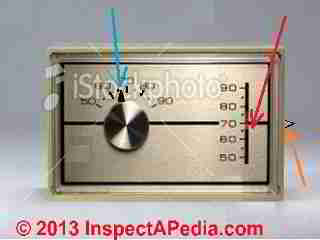 What is this thermostat set to? I would say about 66, but the website I got it from said 68? Which is most accurate?
Thank you. - K.P. 2/27/2013
What is this thermostat set to? I would say about 66, but the website I got it from said 68? Which is most accurate?
Thank you. - K.P. 2/27/2013
Reply:
KP: you sent us a "stock photo" of a room thermostat, so we don't know if the thermostat in this image is what is actually installed on your wall. We re-drew parts of the image for clarity and added explanatory arrows and have these comments:
The blue arrow is pointing to the thermostat's reading of the current room temperature and is just past 65F - probably around 66 or at most 67F as it's less than half way to the 70.
The red arrow is pointing to the set temperature on the thermostat - the temperature that the building occupant is asking for is set by moving a lever on the right side of the thermostat (the orange arrow) and the "set temperature" being called for is visible by that horizontal red line in the vertical scale on the right portion of the thermostat.
The image shows the red line just about exactly between 65F and 70F - or about 67-68 °F.
In sum, in this sketch the thermostat is set to call for heat up to 67F. and the room temperature is reading as just a degree or two below that.
Watch out: the wall thermostat is not a lab-grade absolutely precise instrument in setting nor is it precisely accurate in reading, and even if it were, it would only be reading the temperature right there at the thermostat, not at other places in the room.
It would be unreasonable to expect precise, to the millimeter, agreement between the room temperature read-out on the round dial and the room temperature setting on the vertical scale.
How a Digital Room Thermostat Works
Reader Question: Why Does the Thermostat Display Jump Back to 83 After I set It to 68 Degrees?

My daughter had a thermostat replaced about 2 months ago [Trane unit] replaced with Honeywell digital thermo worked well.
Today she called me and said that the thermostat is saying 83 degrees and when she sets it to 72 degrees it jumps back to 83 degrees/she says the thermo is set on the cool side.
Do you know what the problem may be. Please advise - Thank you John
Reply: How a Single-Display Digital Room Thermostat Works
A competent onsite inspection by an expert usually finds additional clues that help accurately diagnose a problem with air conditioning systems and controls, possibly including something you were not considering. That said, there may not be any thermostat problem in the case you describe. At least not with the thermostat itself.
Our first photograph (above left) shows a basic Honeywell digital room thermostat. This one happens to be set in Heating mode but the principle of how the display works is the same in both heating and cooling modes. You'll see that the display shows the time (12:15 pm) and the current room temperature (67 °F - the house was already cool).
In normal operating mode a digital thermostat whose indicator window shows only a single temperature number displays the current room temperature that it is sensing.
When you press the temperature "set" buttons to call for a decrease in room temperature, (say for air conditioning) or an increase in room temperature (say when in heating mode), the thermostat temperature display temporarily changes to show the "set" temperature - the temperature you are calling for.
When you stop pressing the temperature "set" buttons the thermostat display returns to showing the current room temperature.
Our second digital room thermostat photo (left) shows me pressing the "set down" button until the display shows 54 °F.
This is the new "set" temperature or the temperature I am calling for at the thermostat.
Our third Honeywell digital room thermostat photo (above) shows that a moment after I removed my thumb from the "set" button the thermostat display returned to showing the current actual room temperature (67 °F).
So if the current room temperature for your daughter was actually 83 °F (or in my case 67 °F), that is the number that will show both before and after pressing the "set" buttons.
Only while the set buttons are being pressed will the display show a different temperature (the temperature you are calling for).
As the A/C turns on and begins to lower the room temperature you should see the displayed room temp number gradually drop until it reaches the set temp.
It's possible that your daughter's thermostat is therefore working normally but she simply didn't previously notice how it's display behaves. Often when we notice something for the first time we think there has been a change even if that is not the case.
Two exceptions to this description of how the display on a digital thermostat works
First: if the A/C or heating system is not working properly then even after changing the "set" temperature on the thermostat nothing will happen, or the system may run but never reach the set temperature.
Second: some digital thermostat models show not just one, but two temperatures in the display. One of these is the "set" temperature and the second is the "current" or "actual" temperature. If your daughter's display is one of this type, then it may not be working properly. But from your description it sounds as if she's got a single-display model.
Watch out: if your heating system electrical power has been shut off, when power is restored the thermostat might have "forgotten" the program that you had set into it and you'll need to re-program the device by setting the correct time and then the desired room temperature set back time, and temperature.
Honeywell's Current Round Non-Programmable Thermostat
Above is Honeywell's current (2018) digital, non-programmable room thermostat and below are links to more information about this control.
In this thermostat the display and temperature setting works as follows:
A small indicator triangle pointer tells you if the display is showing the actual room temperature "Room" or the thermostat's set temperature "Set"
An adjustement to the thermostat is activated by turning the round dial 1 click to move the pointer from its default display of "Room" down to "Set"
Turning the dial further counter-clockwise lowers the Set temperature.
Turning the dial further clockwise raises the Set temperature.
- HONEYWELL T8775 THERMOSTAT USERS MANUAL [PDF] retrieved 2018/08/02, original source: https://customer.honeywell.com/resources/techlit/TechLitDocuments/69-0000s/69-1679EF.pdf
Below is the long-established round analog Honeywell thermostat (2018 model) still available as the Honeywell CT-87.
- HONEYWELL CT-87 THERMOSTAT USERS MANUAL [PDF], retrieved 2018/08/02, original source: https://customer.honeywell.com/resources/techlit/TechLitDocuments/69-0000s/69-1919EFS.pdf
Heating & Cooling Control Thermostat Troubleshooting Guide
We have moved and expanded this discussion to a separate article found
at THERMOSTAT DIAGNOSTIC GUIDE
...
Reader Comments, Questions & Answers About The Article Above
Below you will find questions and answers previously posted on this page at its page bottom reader comment box.
Reader Q&A - also see RECOMMENDED ARTICLES & FAQs
On 2018-04-18 by Kent Foster - thermostat won't let me set temp below 65
I have an old (10 years maybe) American Standard Heat and AC thermostat on wall.
It won't let me turn the AC lower than 65, but the actual temp says 79 (too hot at night). Should I replace the thermostat for one that allows me to turn it down to less than 65, with the goal in mind to get the actual temp. to around 73?
(Apr 19, 2017) Mod said:
Kent,
I don't think that the thermostat is the problem. If the air conditioner cannot cool the space to the set temperature, setting the thermostat lower will not fix that.
On 2018-08-02 by Joe Richardson - where do I buy the thermostat shown in your photos?
 I need to buy a honeywell thermostat for my home and the model is exactly the one you display in this troubleshooting guide. Round,, digital display, heat and cold selector switch, fan auto off switch, temp up and down push buttons and set button.
I need to buy a honeywell thermostat for my home and the model is exactly the one you display in this troubleshooting guide. Round,, digital display, heat and cold selector switch, fan auto off switch, temp up and down push buttons and set button.
ive looked for one of these for a year and this site is the first time ive found one. I dont know the model or where i can buy one.. can you help with a model number of possibly where i can buy one?
On 2018-08-02 by (mod) - analog-model round wall thermostat, the Honeywell CT87N
Honeywell also still produces an analog-model round wall thermostat, the Honeywell CT87N
Joe,
I found, purchased, tested, and installed the round digital-display Honeywell room thermostat from units on display at a New York Home Depot building supply store.
Honeywell's round, digital, NON-programmable thermostat current model is the T8775X shown below and described by Honeywell at https://www.honeywellhome.com/en/products/thermostat/digital-the-round-non-programmable-thermostat - it's a bit newer than the one I show at the top of this page but is functionally the same.
A small indicator triangle pointer tells you if the display is showing the actual room temperature "Room" or the thermostat's set temperature "Set"
An adjustement to the thermostat is activated by turning the round dial 1 click to move the pointer from its default display of "Room" down to "Set"
Turning the dial further counter-clockwise lowers the Set temperature.
Turning the dial further clockwise raises the Set temperature.
On 2015-12-27 by Jakki - can't get room warm enough
My heater thermostat reads 72, portable thermostat reads 66. What to do beside using space heaters?
On 2015-12-28 by (mod) -
Jakki
If your portable thermostats (what are these controlling?) are not located exactly the same as a wall-mounted thermostat for your central heating system indeed they will show different temperatures.
If your wall thermostat properly turns your central heating system on and off normally but the thermostat is satisfied while you, elsewhere in the room, are too cold, you can either turn up the heat to a higher setting or you can ask your heating tech to investigate the placement of the thermostat itself. For example a thermostat placed on a wall that is being heated by a warm air supply duct, sunlight, hot water pipes, etc. can think the room is warmer than it is.
Start by checking that the thermostat's temperature sensor is not blocked by dust or debris and that the thermostat is not exposed to direct sun or to warm air coming out of a nearby warm air supply register.
On 2015-01-07 by Anonymous - what does em.heat stand for
what does em.heat stand for on a Honeywell digital
On 2015-01-07 by (mod) -
Anon:
Em-Heat refers to "emergency" or "backup" heat and is used in heat pump systems to indicate that the heat pump, unable to keep up with heat demand in cold weather, has switched to whatever backup heat the system has installed - such as electric heaters in the air handler.
See https://inspectapedia.com/aircond/Backup_Heat.htm for details
On 2014-06-27 by stan brown
Honeywell thermostat indicates room temp, is 80 degrees ,when I have it set for 73 degrees cooling. This is upstairs, downstairs is on exact temp, set for.
I have two separate units fpr both levels and they have both been replaced with new units within last year.
On 2014-06-27 by (mod) -
Stan check THERMOSTAT DIAGNOSTIC GUIDE to see why your system is not cooling
...
Continue reading at THERMOSTAT SETBACK ADVICE or select a topic from the closely-related articles below, or see the complete ARTICLE INDEX.
Or see these
Recommended Articles
- THERMOSTAT INSTALLATION & WIRING MANUALS
- THERMOSTAT DIAGNOSTIC GUIDE
- THERMOSTAT SETBACK ADVICE
- THERMOSTAT SWITCHES, EXTERNAL
Suggested citation for this web page
THERMOSTAT SETTING INSTRUCTIONS at InspectApedia.com - online encyclopedia of building & environmental inspection, testing, diagnosis, repair, & problem prevention advice.
Or see this
INDEX to RELATED ARTICLES: ARTICLE INDEX to HVAC THERMOSTATS
Or use the SEARCH BOX found below to Ask a Question or Search InspectApedia
Ask a Question or Search InspectApedia
Try the search box just below, or if you prefer, post a question or comment in the Comments box below and we will respond promptly.
Search the InspectApedia website
Note: appearance of your Comment below may be delayed: if your comment contains an image, photograph, web link, or text that looks to the software as if it might be a web link, your posting will appear after it has been approved by a moderator. Apologies for the delay.
Only one image can be added per comment but you can post as many comments, and therefore images, as you like.
You will not receive a notification when a response to your question has been posted.
Please bookmark this page to make it easy for you to check back for our response.
IF above you see "Comment Form is loading comments..." then COMMENT BOX - countable.ca / bawkbox.com IS NOT WORKING.
In any case you are welcome to send an email directly to us at InspectApedia.com at editor@inspectApedia.com
We'll reply to you directly. Please help us help you by noting, in your email, the URL of the InspectApedia page where you wanted to comment.
Citations & References
In addition to any citations in the article above, a full list is available on request.
- "Thermostats" U.S. Department of Energy, November 26, 2013, original source http://energy.gov/energysaver/articles/thermostats, retrieved 3/16/2014
- [1] Proliphix Corporate Headquarters [Website: proliphix.com] , 3 LAN Drive Suite #100, Westford, MA 01886 Phone: +1.978.692.3375 Toll Free (U.S.): 866-IP-LIVING (866.475.4846) Fax: +1.978.692.3378 - Sales: sales@proliphix.com Marketing: marketing@proliphix.com Customer support: support@proliphix.com http://www.proliphix.com/ - quoting from the company's website:
All Proliphix Network Thermostats come with our free Uniphy Remote Management Service. This unique offering lets you monitor and control your HVAC systems by simply pointing your Browser to our secure Proliphix Web Site. Enjoy the convenience of programming a thermostat from any location, using a simple graphical interface. No computer equipment or software is required. And since Proliphix takes care of the network configuration for you, you’ll be up and running in no time. We’ll even proactively monitor your thermostats and send you an immediate email or SMS message when an HVAC problem is detected. - [2] "The Nest Learning Thermostat", Nest Thermostat, 900 Hansen Way Palo Alto, CA 94304, Tel: 855-4MY-NEST, Email: info@nest.com, website http://www.nest.com/, retrieved 1/24/2013.
- [3] Honeywell Controls, the company wants you to use their contact form at this web page: http://www51.honeywell.com/honeywell/contact-support/contact-us.html
Honeywell Consumer Products, 39 Old Ridgebury Road Danbury, CT 06810-5110 - (203) 830-7800
World Headquarters, Honeywell International Inc., 101 Columbia Road, Morristown, NJ 07962, Phone: (973) 455-2000, Fax: (973) 455-4807 1-800-328-5111 - [4] Honeywell Corporation, Honeywell T451A, T651A, T694A,B,D,F Light Duty Line Voltage Thermostats, [installation, troubleshooting manual], 1992, Honeywell Consumer Products,
39 Old Ridgebury Road Danbury, CT 06810-5110 - (203) 830-7800 copy on file as Honeywell_Line_Voltage_T651A.pdf
World Headquarters, Honeywell International Inc., 101 Columbia Road, Morristown, NJ 07962, Phone: (973) 455-2000, Fax: (973) 455-4807 1-800-328-5111 copy on file as Honeywell_Line_Voltage_T651A.pdf
"T451, T651, T694 Thermostats provide on-off control of valves, fans, motors, contactors, electric heat elements, duct furnaces and fan coil units in heating/cooling systems. Switching sub-bases provide manual control of heating, cooling and fan." - [5] Honeywell Corporation, "Honeywell Thermostats", website http://www.honeywell-thermostat.com/line-voltage.html retrieved 3/16/13
- [6] Honeywell EConnect™ Wireless Thermostat Kit TL9160AR System Installation Guide, retrieved 3/15/13, copy on file as Honeywell_EConnect69-2474EFS.pdf
- [7] Trane, Ingersoll Rasnd Residential Solutions, Trane PO Box 9010, Tyler TX 75711, Website www.trane.com
- [8-10 pending]
- [11] White Rodgers Thermostats and HVAC controls,
Homeowner information: http://www.emersonclimate.com/en-US/brands/white_rodgers/Pages/wr-homeowner-info.aspx
Contractor information: http://www.emersonclimate.com/en-US/brands/white_rodgers/wr_contractor_info/Pages/white-rodgers-contractor-info.aspx
White Rodgers Product Catalog (don't misspell the company's name as White Rogers Thermostats) -
http://www.emersonclimate.com/Documents/thermostats.pdf - Thermostat Catalog - [12] Domestic Central Heating Wiring Systems and Controls, 2d Ed., Raymond Ward, Newnes, ISBN-10: 0750664363, ISBN-13: 978-0750664363, Quoting from Amazon.com:
This unique A-Z guide to central heating wiring systems provides a comprehensive reference manual for hundreds of items of heating and control equipment, making it an indispensable handbook for electricians and installers across the country. The book provides comprehensive coverage of wiring and technical specifications, and now includes increased coverage of combination boilers, recently developed control features and SEDBUK (Seasonal Efficiency of Domestic Boilers in the UK) boilers ratings, where known.
In addition to providing concise details of nearly 500 different boilers fuelled by electric, gas, oil and solid fuel, and over 400 programmers and time switches, this invaluable resource also features numerous easy-to-understand wiring diagrams with notes on all definitive systems. Brief component descriptions are provided, along with updated contact and website details for most major manufacturers. - [13] "Automatic Oil Burner Controls - Thermostats", Domestic and Commercial Oil Burners, 3rd Ed., Charles H. Burkhardt, McGraw Hill, 1969 (and later editions), ASIN B0000EG4Y8
- [14] Hunter Fan 2500 Frisco Ave. Memphis, TN 38114 888-830-1326 www.hunterfan.com
- [15] Trane TCONT800 Series Touch Screen Programmable Comfort Control Ownes Guide, American Standard, Inc., Troup Highway, Tyler TX 75711, January 2005, Telephone: Customer Service: 1-877-3381, website: www.trane.com
- [16] Boilers, Boiler Conversions, James E. Brumbaugh, ISBN 0-672-23389-4 (v. 1) Volume II, Oil, Gas, and Coal Burners, Controls, Ducts, Piping, Valves, James E. Brumbaugh, ISBN 0-672-23390-7 (v. 2) Volume III, Radiant Heating, Water Heaters, Ventilation, Air Conditioning, Heat Pumps, Air Cleaners, James E. Brumbaugh, ISBN 0-672-23383-5 (v. 3) or ISBN 0-672-23380-0 (set) Special Sales Director, Macmillan Publishing Co., 866 Third Ave., New York, NY 10022. Macmillan Publishing Co., NY
- Our recommended books about building & mechanical systems design, inspection, problem diagnosis, and repair, and about indoor environment and IAQ testing, diagnosis, and cleanup are at the InspectAPedia Bookstore. Also see our Book Reviews - InspectAPedia.
- In addition to citations & references found in this article, see the research citations given at the end of the related articles found at our suggested
CONTINUE READING or RECOMMENDED ARTICLES.
- Carson, Dunlop & Associates Ltd., 120 Carlton Street Suite 407, Toronto ON M5A 4K2. Tel: (416) 964-9415 1-800-268-7070 Email: info@carsondunlop.com. Alan Carson is a past president of ASHI, the American Society of Home Inspectors.
Thanks to Alan Carson and Bob Dunlop, for permission for InspectAPedia to use text excerpts from The HOME REFERENCE BOOK - the Encyclopedia of Homes and to use illustrations from The ILLUSTRATED HOME .
Carson Dunlop Associates provides extensive home inspection education and report writing material. In gratitude we provide links to tsome Carson Dunlop Associates products and services.



